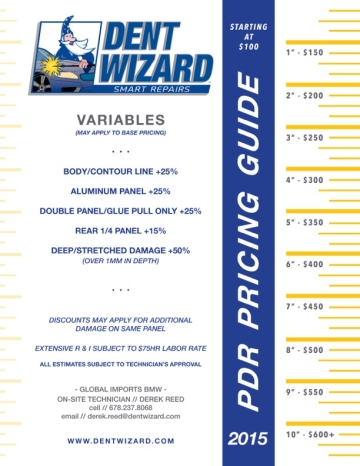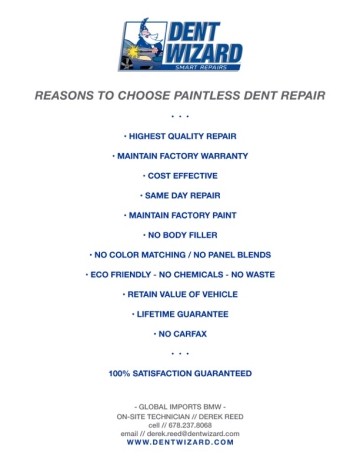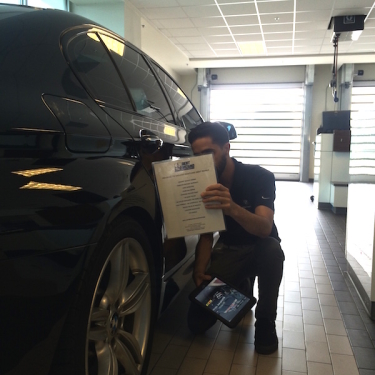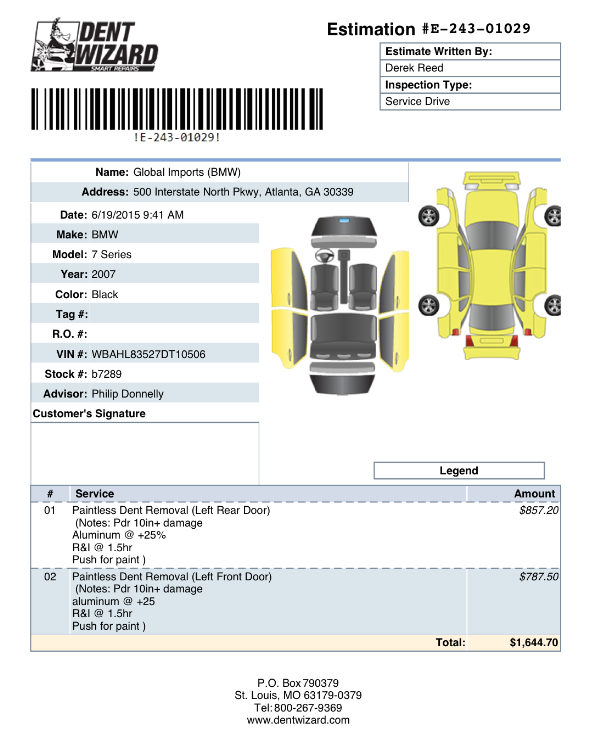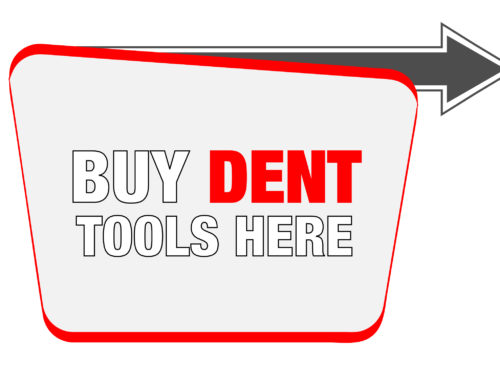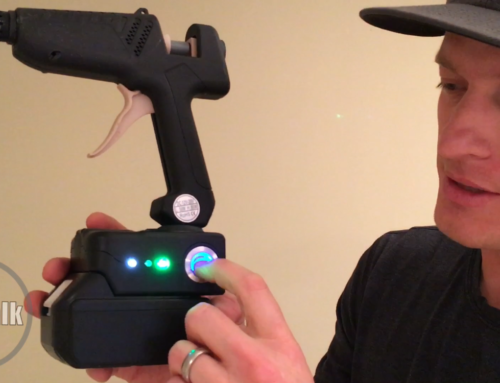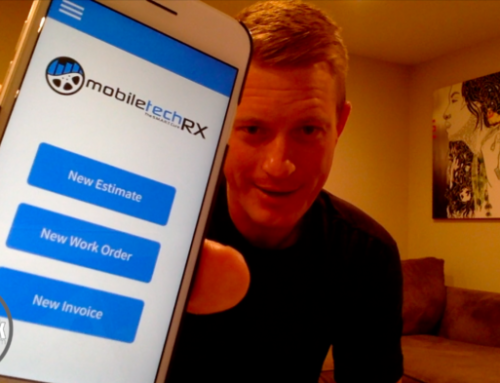with: Derek Reed, Dent Wizard (Atlanta, Georgia USA)
How do you determine a price when selling paintless dent repair to individual retail customers? A lot of PDR guys will say, “Every dent is different, and I know how much to charge from experience.” There is some truth to that statement. Dents in cars are caused by random acts of impact. Thus every dent has a different shape, size, depth, location, and several other factors that make it more or less difficult to repair. If damage on a car is more difficult to repair and requires more skill and time, it should be priced accordingly. Instead of pulling numbers out of thin air, some PDR techs have developed systems or guides to help them determine proper pricing for varying types of damage. In the past year a growing momentum of using retail pricing guides has taken ahold of the PDR community. That charge has been lead by Paul Kordon amongst others. Paul did an awesome job explaining how he uses his guide to justify conventional body shop equivalent prices for paintless dent repair on a recent episode of the PDR College podcast. Derek Reed is another high level PDR tech who joined the discussion online and decided to implement a similar system in his daily routine of selling retail work in a service lane. Derek recently shared his paintless dent repair journey with PDRtalk and told us how he has used his guide to increase production and revenue.
When and how were you introduced to PDR?
I was introduced to PDR in 2002 by my uncle, Dennis Rorke Jr. at the age of 18. At the time I was an aspiring musician, and he set me up with an interview with Dent Wizard to try and give me a career with a future. Without going into details, the interview did not go as planned and I did not get the job. I spent the next few years as a full time musician with various part time jobs between touring and trying to “make it” with my band. In 2006 I realized I had made a mistake and asked Dennis for another opportunity. He was kind enough to give me another referral and this time I did everything correctly. I was living in Detroit at the time, and had very little in the way of possessions. I got a call on a Wednesday from Dent Wizard asking if I could be in Indianapolis Friday morning for an interview. I immediately packed everything I owned into a Ford Focus zx3 and drove to Indianapolis. I interviewed Friday morning, got the job, and drove to St. Louis that weekend to start training Monday morning. The next Friday was my 23rd birthday.
I’ve heard the training at Dent Wizard is pretty intense. How long did it last? Were a lot of guys weeded out during the process?
The training with Dent Wizard is definitely very intense. It is an 8 week training course and has a fairly fast paced structure without losing focus on detail. I had no previous experience in the automotive industry beyond the fact that all of the men in my family worked on the assembly line for one of the big 3 in Detroit, but by the end of the course I was #1 in my class and had the feeling that I was born to do pdr. The pass/fail rate fluctuates obviously, but I believe the average is around 40% passing. My class started with 23 and ended with 11 or 12. Some left early upon realizing it wasn’t for them, and others were dismissed later after trainers realized they were not getting it. The training involves weekly testing and it is not likely you will last if you are not able to pass. Despite popular opinion amongst pdr technicians, Dent Wizard does have very high standards for their technicians to get certified. It is a very well thought out and orchestrated training, but as with anything in life, it is then left up to each individual person to continue on that path or not. Some get it. Some don’t.
Have you always worked in Atlanta, or have you moved around?
I started in Indianapolis, IN. right out of training. I spent a while working an auction there before moving into service drive work at a Volvo/Land Rover/Jaguar complex. All three dealerships in one building with individual service drives. After a while there, I was asked to try to build a route in Fort Wayne, IN. I was doing my drives in Indianapolis every morning and then driving 2hrs to Fort Wayne to do my wholesale accounts. Eventually I scored a Mercedes drive in Fort Wayne and decided to move up there to focus on growing that market. Dent Wizard basically left me alone to build and maintain that market however I saw fit. After a while in Fort Wayne they asked me to move BACK to Indianapolis to take over a Lexus service drive. I ended up working that as well as landing a Porsche/Audi drive and a Mercedes drive across the street. They were all within visual distance from each other and I could basically roll my tools from place to place as needed. I did this for a few years before being forced to move after we lost the entire dealer group. Long story short; the owner passed away and left the group to his son. His son had a friend who had some pdr tools….. He got the accounts and I was pushed out. Dent Wizard offered me 7 choices of cities to move to where they needed a tech. I instantly declined anywhere that had regular snowfall each year or regular 100+ degree temps. I chose Atlanta. I was given a BMW account that our tech was having trouble with, and I’ve been there full time for 5.5yrs. Dent Wizard ended up getting the Indianapolis dealer group back within 3-4 months of me moving to Atlanta and is still maintained to this day by my uncle… Who I might add is an incredible technician.
You recently started using a pricing guide when estimating dent repair for individual retail customers. Before the guide, how did you come up with prices for PDR?
Honestly, like a lot of technicians, I did not have any system. When I started I was told “you probably want to get about $100-130 for this kind of repair. Anything above that is up to you.” Through my years of service drives I have always been playing with the prices. Trying to figure out where I should be at, and what people will pay. I had gone really high and really low and everywhere in between. I could never really dial in the “answer” and was always just looking at the damage and writing a number on a piece of paper that had a diagram of a car on it. This always felt weird to me, but that is just how most people are trained I guess. To me it always felt similar to if I was sitting on a sidewalk asking for spare money. It wasn’t until last year or so that I realized the actual number was irrelevant. The presentation and information is the key.
How did you develop the guide you are currently using? Explain the basics of the guide. Are repair prices based on size, depth, quantity, location, obstructions, etc?
In all absolute honesty, my guide was highly inspired by Paul Kordon. The idea of the guide had always been there. Dent Wizard has always given me a price guide for my drives, but the pricing system was weird, the guide was not entirely attractive, and it was just nothing special. After meeting Paul and discussing what he was doing, I realized how much better it could be with a little effort. He definitely had a system down, and as he is a hero of mine in the industry. I knew I needed to emulate his method a little. My guide was designed by my wife, who has a degree in graphic design. We spent a lot of time simply playing with the visual aesthetics. She is really into color stimulation in marketing and the difference that simple color and font choices can do to the brain. Once we had the design down, the rest was easy. The guide is very simple: a ruler on the right side with pricing by the inch. The left side has additional markup details such as aluminum, double panel/glue pull only, etc. The guide is used to measure the length of the damage primarily which gives a general PDR cost, and then that is up charged based on a % dictated by additional variables on the left. Depth is addressed In this variable section where I state that any damage deeper than 1mm may be subject to a 50% increase. Utilizing the Black Plague Dent Depth Gauge (a genius tool in its own right) I can then justify additional cost into the repair. Another thing that has been great was adding a simple 15% to any repair on a rear 1/4 panel. Some people called me crazy for this and said it would never work, but the simple truth is that 90% of all 1/4 panel repairs require some sort of r&i or have some added obstacle. This is especially true with my primary repairs being bmw, which the guide is tailored to almost specifically. I’ve tried to include as much info on the guide to accommodate for any scenario, without having it look cluttered or greedy. The guide has a vagueness to it that allows adaptability per estimate.
When using the guide, do you have a standard sales system or protocol when interacting with your potential retail customer?
I have specific ways that I present the guide, but that’s about it. Always holding it in a certain way, or making sure they see me point to the stuff on the guide as I explain each step. As I stated above, I tried to leave the guide intentionally vague. We all know that no two customers are the same, just as no two repairs are the same. I use my years of reading customers to dictate how I will use the guide or even if/when I will use it. Just because I have it, does not mean I use it 100% of the time. Sometimes I know the customer will be easy to work with and I will use it to its fullest. Other times I know they will want to negotiate and I have my work cut out for me. Instances like this allow me to use the guide as an anchor and work from there. I know I will have to negotiate, so I make sure I don’t miss anything in order to get my anchor price up there where it belongs while leaving myself room to work down. Other times I have actually used the guide against itself. For instance: I will use the guide to get a very high price and then spin it in a way that makes the guide take all of the negativity. “Oh wow. According to my guide here, this is a $1287.50 repair! Tell you what, that seems a little crazy to me honestly. The damage is not really THAT bad… Let’s call it $1000.” This allows me to shift the blame onto the guide and then I get to be the hero. In the end, a guide is just a tool. You still have to be able to read the customer and adapt its use to each specific sale.
Have you distributed your guide to service advisors and body shop estimators that you work with? If so, what has been the response?
Absolutely! This was one of the main reasons for making the guide. I have 18 advisers that roll an average of 150 appointments through the drive every day plus I do a lot of wholesale every day. Honestly, I do not even have time to be on the drive very often. I rely on them mostly to sell work for me. I gave each adviser a laminated version of the guide, which has key selling points printed on the back. I also purchased the new Collision Magicians Dent Light iOS app for all of their iPads to use in tandem with the guide. Most of them have been working with me for years and were already comfortable with my pricing, but now they really can’t mess it up. I did a few training sessions with them as a group and I’ve done individual training with some of them that are really into it. I don’t work with any bodyshops myself, but I have made over 30 customized versions of my guide for other Dent Wizard techs and it seems to be working well in all scenarios. My advisers specifically love it! Some of them have doubled their sales with ease. So much so that I barely have the opportunity to use it myself these days because I’m always pushing metal. Most of them are comfortable anywhere up to about 6″ on the guide. Once they cross that threshold, I ask them to call me so I can come up and do the estimate myself. This is when I grab my light, my depth gauge, the guide, etc. and get to have my fun with it. Always making sure to include the adviser in on the process as an impromptu training session. I’m basically using this moment to train/educate them as much as I am trying to educate the customer. It is also worth mentioning that as I designed the guide, I had about 10 different versions. Each time I changed something I gave a new revision to my top 5 advisers and had them test it out. They would use it a few days and then give me suggestions or input from customers and I would revise it further. The guide took about 3 months and saw 10 or so variations before we were all happy with it. This got them involved and gave them a sense of ownership to it, which helps their confidence when using it. Don’t be afraid to use your customers as a test group. Get their input!
In your opinion what benefits are achieved when using a pricing guide? Less negotiating, more trust or transparency, higher prices, etc?
Yes! All of that. Information is Justification! Everything experienced when using a guide is a benefit. I have yet to see any downside. You get to educate the customer by going over the stuff on the guide. You get to slow the estimate down and really explain each step and why it cost an extra 15% here or 25% there. I have experienced very little negotiating after fully implementing the guide, it has a sense of “it is what it is and I just told you why” built into it. This also goes along with the fact that I use a very in depth app on my phone designed by Dent Wizard to itemize and print out the estimate. They can look at it and instantly see how the number was achieved and this is huge to customers especially when you get into the higher pricing. You can spit out $100 verbal estimates all day and maybe get a few, but when you hand a printed piece of paper that says $112.75 and WHY… it is a completely different ballgame. The guide also provides a more fluid approach to your sale. When estimating with a customer next to you, any awkward pauses or moments of “hmmmm. Yeah.. I don’t know.. ” can be the end of the sale…. Unless done intentionally, but that is a different discussion of sales techniques. I can roll into an estimate and although keeping it slow, it remains steady with the tools to fill in the spaces. It adds consistency as well, which is huge if you are dealing with service advisers or people that will be presenting the estimate to the owner of the vehicle. If you are always winging it, they won’t ever feel comfortable enough to sell for you on a consistent level because they do not understand what is too high or too low. There exist many many other benefits that I am still learning about, and of course higher prices are a huge perk.
How much more revenue have you generated since implementing a pricing guide?
I haven’t honestly been using it long enough to get too detailed here, but I can say over the last 6 months of playing with the idea my numbers have grown each month. Since 3 months ago when I truly implemented the finished product and got them in the hands of all my advisers, I’m averaging an increase of 5-7k a month. Each month is getting higher and higher and I have even broken a few of my personal records recently on monthly goals as well as individual job pricing. Last year I did my first $1000+ retail job, and now I’m doing them very regularly with little to no hesitation from the customer. I did 2 this last week that were $1500+ and both were priced with the guide and on printed inspection sheets. Both approved within 1 minute of seeing the print out. It’s pretty amazing the difference that it’s making. Also worth noting that as I said I’ve given about 30 customized versions to other Dent Wizard techs around the country and I am getting calls daily telling me about how amazing it is. I even have a tech who is using my retail guide simply as a way to justify wholesale up charges and he is killing it! This has lead to a new guide I am creating for him and a few others that will be specific to wholesale. We are on version 2 of the wholesale guide and it’s looking very promising.
Any advice for techs thinking about creating and implementing a pricing guide for retail PDR?
It’s more than just putting prices on a piece of paper. Take the time to consider every single detail from page alignment, color choices, font, and everything in between. For instance: I spent a week deciding whether to put the actual prices above or below the inch markers on the ruler. One way means it is a specific price up to that point and the other dictates that it is this price after this point. Everything you put on it will play a role in the mental and psychological state of you and your customer. It all deserves independent consideration.
Have a standard structure. Decide on your pricing increment structure, and stick with it. If you are doing $50 an inch, then do $50 an inch even if you start to question it around the 10-12″ area.
Keep it informative but uncluttered. Make sure you get in your variables and up charges, but you don’t need 20 of them. Choose them wisely and fairly. I based mine on “anything that you would complain about to another dent tech.” Are you always dealing with sound dampening material? Does it make your job harder? Charge more for it. Do you work on laminate glass daily? Charge more for it! Just try not to get too carried away. Don’t like working on white cars? Me either, but I don’t charge more for it. Hah. My initial markup list had about 10 items on it that I narrowed down to my vital 5 issues. Keep it clean and fair.
If you have a specific location/account in mind, put their info on it. Make custom guides for every service lane, dealership, and body shop you service. This makes them feel important and also allows you to tailor it for a specific manufacturer if you wish. Each brand has its own unique challenges and you can use that on the guide. I don’t have laminate window up charges on my bmw guide which leaves room for other stuff, but I put it on guides that are going to Mercedes or Lexus accounts. Subaru account? Maybe charge more for glue pull only areas or even add a disclaimer about glue pulling to it.
Allow your customers to have input! If you have advisers or estimators that will be using it, let them have some input in its design and functionality. Get them involved and they will take more pride in it as well as understand how to use it better.
It’s just a tool, but a tool with many applications. Do not limit it to any specific style of use. Learn to adapt it into any and all situations? Experiment with various versions until it’s perfect. Once you commit to it, commit to it! Don’t be shy when the prices start getting really high. Let the guide dictate your prices and be confident with it. If it’s a nasty bodyline dent on an aluminum door with laminate glass and under a brace….. Price it accordingly. You can always go down from there, but at least you will have a great anchor price.
Lastly: pay attention. Listen and learn from the guys already using this method. If you aren’t paying attention to stuff like PDRCollege, Dent Tech Magazine, PDRtalk, and being involved in the Facebook groups or other online forums….. You are selling yourself and your repairs short. Be involved and help the technician next to you regardless of what shirt they are wearing. We are an industry and we need to come together as one.
Before I am done I want to give a huge thank you to my heroes in the industry. These guys have really helped me and everybody else over the last few years or my entire career and they truly understand what it means to be industry leaders. My Uncle Dennis Rorke, Keith Cosentino, Shane Jacks, Paul Kordon, Sal Contreras, John Highly, Myke Toledo, Brice Kelly, my brothers in the DWPDR Group, and that person I’m forgetting that I will remember tomorrow and feel like crap about. Thank you guys. Sincerely. Thank you for the inspiration. The motivation. The challenge. The help. All of it. I know I am better today and will be even better tomorrow because of all of you, and I know I am not alone.
Special thanks to Richard Routson for giving me this opportunity and making me think that people actually want to hear what I have to say. Haha. I hope it helps somebody succeed and make our industry better. If anybody would like to contact me personally, please do not hesitate. Furthermore, if anybody is interested in having a guide custom designed for their company, my wife would be glad to help out with that. Contact me and we will do whatever we can to help you achieve your vision for your own price guide.
Sincerely,
Derek Reed
5 Star / World Class Technician
Dent Wizard
derek.reed@dentwizard.com
UPDATE: Derek was recently featured on a very informative episode of PDR College. He shared tons of valuable information on how he gains dealership accounts and the special systems he uses to maximize production and revenue at his mega dealership in Atlanta, GA. Listen to the podcast here and “Get Better!”
A note from PDRtalk.com – There is no nationwide or world wide standard for pricing PDR services. Pricing/estimating guides are designed and used by individual corporations and proprietors to establish a baseline for varying types of damage that can be repaired with PDR. The price derived from such systems is only a suggestion.

